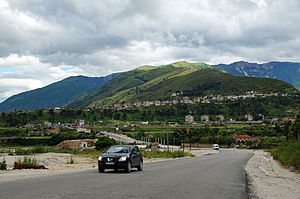Tepelena
|
Tepelenë Tepelena |
||

|
||
|
Coordinates: 40 ° 18 ' N , 20 ° 1' E |
||
| Basic data | ||
|---|---|---|
| Qark : | Gjirokastra | |
| Municipality : | Tepelena | |
| Height : | 200 m above sea level A. | |
| Area : | 431.24 km² | |
| Residential place : | 4342 (2011) | |
| Bashkia residents : | 8949 (2011) | |
| Population density (Bashkia): | 21 inhabitants / km² | |
| Telephone code : | (+355) 0814 | |
| Postal code : | 6301 | |
| Politics and administration (as of 2019 ) | ||
| Mayor : | Tërmet Peçi ( PS ) | |
| Website : | ||
| Culture and history | ||
| City foundation : | 15th century | |
 City View (2014) |
||
Tepelena ( Albanian also Tepelenë , from Turkish Tepedelen ; Greek Τεπελένι Tepeléni ) is a small town with 4,342 inhabitants (as of 2011) in southern Albania . It is located in the Vjosa Valley and is best known as the birthplace of Ali Pasha .
In the summer of 2015, Tepelena was merged with the other municipalities in the south of the former Tepelena district. The municipalities Kurvelesh (705 inhabitants), Lopës (723 inhabitants) and Qendër (3179 inhabitants) were incorporated. Since then the community has had a total of 8949 inhabitants (as of 2011).
Geographical location
Tepelena lies on the left bank of the Vjosa on a plateau above the river. The Vjosa turns north here after breaking a mountain range in the Këlcyra gorge a few kilometers earlier . In addition, the Drino River flows here . To the north of the city, the Bënça, coming from the Kurvelesh from the southwest, flows into the Vjosa.
Thanks to the location where these two valleys meet, Tepelena has always been an important traffic junction in the southern Albanian mountainous region. The SH 4 , the road from Fier to Gjirokastra and the most important connection to the south of Albania, still runs through the town today. It is 75 kilometers to Fier in the north-west and 30 kilometers to Gjirokastra in the south-east. To the east, the road branches off to Përmet and Korça .
The cityscape is dominated by the Ali Paschas fortress, which towers on a steep rock outcrop high above the Vjosa.
history
Today's Tepelena is an Ottoman city foundation. So the name of the city is of Turkish origin. The city is mentioned for the first time in 1506. A profound Islamization of the area began around 1600 . To this day, the Muslims are the largest religious community in the city. At the turn of the 18th to the 19th century, Tepelena belonged to the domain of Ali Pasha . He had the fortress built and expanded in his place of birth. He resided alternately here and in Yanya . He was visited in both places by the English poet Lord Byron in 1809/10 .
In 1920 the city was badly damaged by a severe earthquake.
Tepelena is one of the few small Albanian towns that have a coat of arms. On a red shield it shows a raised golden lion above a black castle wall with towers. It is reminiscent of Ali Pasha, who was also called the Lion of Ioannina .
economy
The most important company is Uji Tepelena , which bottles mineral water a few kilometers south at the Ujë i Ftohtë spring . The products are also exported to Greece, Italy, Kosovo, England and the United States.
Culture and sights
In the city there is a museum and the fortress from the time of Ali Pasha Tepelena. The latter is around four and a half hectares, but is partly built over. The government declared at the end of 2014 that it wanted to prevent private and public use of the castle complex in order to be able to preserve the cultural monument. A monument by Mumtaz Dhrami in the city center commemorates Ali Pasha Tepelena.
sons and daughters of the town
- Ali Pascha Tepelena (1741-1822), Ottoman Pasha
- Tafil Buzi (1792–1844), Rilindja military activist
- Selam Musai (1857–1920), Rilindja military activist
- Valentina Leskaj (* 1948), politician
- Gramoz Ruçi (* 1951), politician
- Muhedin Targaj (* 1955), football player
- Photo Strakosha (* 1965), soccer goalkeeper
Web links
- Official website of the Bashkia (Albanian)
- Bënça nature reserve near Tepelena: Eco village in Benca Albania. In: A survey about the Nature of Europe. members.lycos.nl, accessed on September 29, 2008 (English, brief outline of the flora and fauna of the region).
Individual evidence
- ↑ a b c Ines Nurja: Censusi i popullsisë dhe banesave / Population and Housing Census - Gjirokastër 2011 . Results Kryesore / Main Results. Ed .: INSTAT . Pjesa / Part 1. Adel Print, Tirana 2013 ( instat.gov.al [PDF; accessed April 14, 2019]).
- ^ Robert Elsie : Historical Dictionary of Albania . In: Historical dictionaries of Europe . No. 75 . Rowman & Littlefield, 2010, pp. 438 ( online version ).
- ↑ a b From Gjirokastër to Tepelenë. Gjirokastra Conservation and Development Organization, accessed November 22, 2014 .
- ↑ Fatmira Nikolli: Artan Shkreli: Kalaja e Tepelenës, hiqen baret e banjat publike. In: BalkanWeb. November 4, 2014, archived from the original on November 11, 2014 ; Retrieved November 22, 2014 (Albanian).

